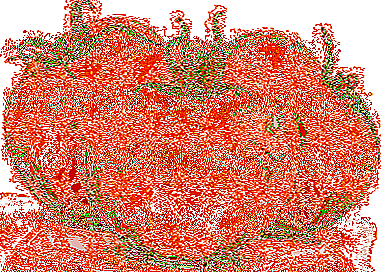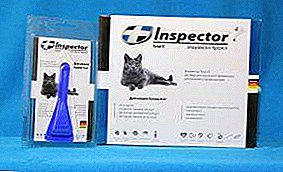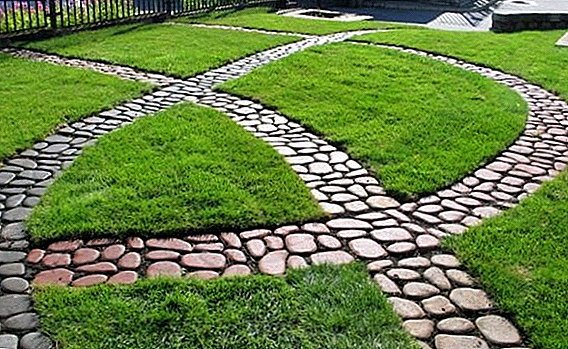 The best material for the manufacture of tracks in the cottages is concrete, as it is very reliable and durable. From it you can make a variety of forms of paths, and it does not require large financial investments. In addition, it is very easy to make a garden concrete walkway on your own, without any experience or appropriate education.
The best material for the manufacture of tracks in the cottages is concrete, as it is very reliable and durable. From it you can make a variety of forms of paths, and it does not require large financial investments. In addition, it is very easy to make a garden concrete walkway on your own, without any experience or appropriate education.
Guide how to make a track from concrete
By the construction of the track should be taken responsibly and do everything according to the rules. 
List of required tools and materials
In order to construct a concrete path, it is necessary to prepare the following tools and materials:
- boards or plywood (for formwork);
- reinforcement (A3, thickness 12 mm - the best option);
- Master OK;
- pointed shovel;
- bucket;
- geotextiles;
- capacity for solution;
- pegs and cord (for marking);
- concrete;
- crushed stone;
- sand (preferably river).
Did you know? Among all the artificial compounds, concrete ranks first - about 6 billion cubic meters of composition are produced annually. Consequently, for every person living on Earth, there is approximately 1 cubic meter.

Track markup
To begin construction it is necessary with a marking. First you need to decide what form the path will have. Then you need to drive pegs around the perimeter, and in between them pull the cord. The more bends the track has, the more pegs are required.
It will be interesting for you to find out how to make a veranda in the country house, garden swings, a fountain, a stone grill, a trellis, a bed of stones, rock arias, a dry stream, a gazebo.
Foundation preparation
Next you need to prepare the base - the pillow serving as a drainage. To this end, remove the top layer of soil to a depth of about 20 cm. Then the bottom level and cover it and the sides of the trench with geotextiles.
Due to this, the concrete will not collapse due to excess moisture after heavy rain and snowmelt. Then pour a few layers of sand, each of which is moistened with water and thoroughly rammed.  The cushion should have a height of about 10 cm. To enhance the drainage function of the base, it is recommended to lay a layer of gravel between the layers of sand.
The cushion should have a height of about 10 cm. To enhance the drainage function of the base, it is recommended to lay a layer of gravel between the layers of sand.
Formwork, curbs and thermal joints
Formwork is the basis for the future path, as its appearance will determine the appearance of the structure. It is a temporary wooden structure that helps to give the necessary shape.  For formwork will need boards with a thickness of 1.5-2 cm and a height of 3-4 cm above the height of the trench. They are attached to the pegs.
For formwork will need boards with a thickness of 1.5-2 cm and a height of 3-4 cm above the height of the trench. They are attached to the pegs.
So that the coating does not crack, it should be separated by expansion joints: transverse dividers, for example, boards, metal or siding, should be placed every 1.5 m. The more such sections will be, the stronger the track will be.
Important! To make the separators easy to remove when finished, they need to be lubricated with engine oil or silicone grease before installation.
Reinforcement
To make the construction durable, it is necessary to place metal elements inside the concrete slab. You can use a netting net, wire, pipe. The reinforcement should be in the middle of the concrete layer, fixed with clamps.
You can install support bricks or make legs out of wire, on which the grid is laid. Without reinforcement, the thickness of the concrete should be 15 cm, with its use a layer of mortar may be less. 
Fill track
To prepare the solution, you need to mix cement and sand in a ratio of 1: 3, respectively. The amount of water should be such that a thick plastic consistency is obtained - about 2-2.5 liters per 1 kg of cement.
If the solution is thick, then there will be difficulties with its distribution. And if the mixture is liquid, it will crack when dry. It is best to use a portable concrete mixer.
It will also be useful for you to learn how to make yourself a wicker fence, a fence of gabions, a fence from a chain-link mesh for the garden.
It mixes the ingredients well, thereby improving the quality of concrete. If such a device is not available, you can use a powerful punch with a nozzle "mixer". It is recommended to add fiber-glass and water-repellent additives to the mix.
Do not refuse to add rubble - this design will be much stronger. The prepared solution is poured into the formwork.
Fill the track with concrete: video
To make it as evenly distributed as possible, use the vibrators designed for this. In the absence of such a tool, they take an ordinary spatula, which will need to vibrate and pierce the concrete.
This is done to remove excess air. A light knock on the formwork is another way to seal. It is necessary to level the top layer by a flat dodochka or by a building rule.
You may also be interested to know how to cover the roof with indian hands, how to glue wallpaper on the walls, how to insulate the window for the winter, how to remove the old paint from the walls.
The device is supported on the edges of the formwork and lead to the length of the path. Smooth surface covered with polyethylene. Such a manipulation will protect the concrete from erosion in case of precipitation, and also will not allow it to dry quickly.
When the concrete is completely cured, the dividers are removed, the joints are cast with the same concrete composition, and the surface is leveled. During the week the path should be watered.  The longer moisture is present in the cement, the stronger the structure will be. After 5 days, the formwork is removed. To make the concrete web brilliant, it is recommended to use specialized impregnations or to polish the surface with wax and synthetic resins.
The longer moisture is present in the cement, the stronger the structure will be. After 5 days, the formwork is removed. To make the concrete web brilliant, it is recommended to use specialized impregnations or to polish the surface with wax and synthetic resins.
Did you know? Concrete is known for about 6 thousand years. It was used in ancient Rome for the manufacture of monuments. After the collapse of the Roman Empire, the composition was not made several thousand years. Modern concrete based on cement has become known since 1884.
Options for decorating concrete tracks
Concrete tracks can be left gray. But in order to give beauty and accuracy to the whole area, the paths can be made spectacular and extraordinary with the help of decor.
Coloring
There are two ways of coloring gray paths. The first is to add color to the concrete mix. This method is more expensive, but in this way it will be possible to achieve a better result.  It is necessary to use a special pigment that is soluble in water to give concrete color. To achieve the desired result, only white cement will have to be taken as a basis.
It is necessary to use a special pigment that is soluble in water to give concrete color. To achieve the desired result, only white cement will have to be taken as a basis.
When mixing gray cement with a dye, a very dull and distorted shade may turn out. The second way to give the desired color of the path - painting the surface.
To do this, use special compounds that penetrate into the concrete by a few millimeters. To obtain a saturated color, it is necessary to paint the surface several times.
The use of forms and stencils
Very often decorate concrete products using stencils and forms. This method allows you to create the illusion of cobblestone or stone paving. Stencils are designs with partitions that form corners or rounding.  To create such a track, you need to make a markup and level the soil. Reason not to doas the stencil consists of separate small parts and does not feel the load. Decking is also not required. - The stencils themselves are the limiter of the concrete.
To create such a track, you need to make a markup and level the soil. Reason not to doas the stencil consists of separate small parts and does not feel the load. Decking is also not required. - The stencils themselves are the limiter of the concrete.
The solution is prepared in the same way. Then put the form on the ground and pour the composition, ram and smooth. After approximately 60 minutes, when the concrete hardens slightly, it can be removed. Stencils are sold in specialized stores.
Or they can be made independently of wooden slats, barrels, giving the desired shape.
It may be useful for you to learn how to make a greenhouse with an opening roof, a polycarbonate greenhouse, a wooden greenhouse, a greenhouse from plastic pipes, a greenhouse from polypropylene pipes, a greenhouse according to Mitlayder.
Stamping
Stamping is another way to decorate concrete paths. With the help of stamps you can create almost any surface that will imitate cobblestones, paving stones, boards, bricks and other building materials.  Stamps come in the form of animal figures, dinosaur footprints, and leaf shapes. The easiest way to buy stamps in stores. When choosing, it is worth paying attention to the degree of rigidity: the larger it is, the easier it will be to print a drawing on concrete. Also stamps can be made independently.
Stamps come in the form of animal figures, dinosaur footprints, and leaf shapes. The easiest way to buy stamps in stores. When choosing, it is worth paying attention to the degree of rigidity: the larger it is, the easier it will be to print a drawing on concrete. Also stamps can be made independently.
To make a printed surface, it is necessary to fill in the usual concrete path. When the mixture begins to set, and it becomes viscous like clay, you can begin to engage in creativity. The first thing to do is to apply a hardener for 2 times, with an interval of 10 minutes.
It can be of any color. Hardener paints the surface, gives hardness and contributes to the quick setting of concrete. Then a separating component is applied, which eliminates the adhesion of concrete to the dies during printing.
This substance can be liquid or loose. Most often used the second option. Apply it by shaking off a wide brush. The next stage is stamping. At this point, the concrete must be plastic.  If it does not stick to the hands, but is pressed to a depth of 5 cm, then you can lay out the form. They are rammed with their feet. Stamps must withstand human weight and not fall into the composition.
If it does not stick to the hands, but is pressed to a depth of 5 cm, then you can lay out the form. They are rammed with their feet. Stamps must withstand human weight and not fall into the composition.
Other methods
Track design can be very diverse and in harmony with the style of the garden:
- Drawing patternsimilar to pieces of flagstone stone. 24 hours after the fill of the track, broken closed shapes are made using a screwdriver, similar to the contours of slab. The width and depth of the slots should not be less than 5 mm. Soil will accumulate in them, creating a complete illusion of masonry.
- Mosaic. Pieces of old ceramic tiles or plates, rhinestones, broken glass, a mirror, and beads are laid on the grasped concrete. All materials should be approximately the same size. They must be laid on the surface in the desired shape and gently pressed into the concrete.
- Prints. On top of the solution that has not yet seized, prints are made. You can use burdock leaves, large shells. You can also leave an imprint of the hands or feet, after having smeared them with Vaseline.
Care of the tracks
That the path from concrete served long and had respectable appearance, it should be kept always clean. The footpath needs to be swept, vacuumed and cleaned from a watering hose. 
Important! It is necessary to get rid of the weeds growing between the plates, as they crumble the basis of the structure.
Weed grass can be removed by hand or herbicide treatment. Cracks may form on the concrete tracks. Small and isolated flaws can not touch. But growing cracks must be wiped with a solution to avoid complete cracking and destruction.
The advantages of concrete tracks
Consider the advantages of concrete tracks:
- durable composition;
- long term use;
- easy to make a concrete structure;
- low cost of materials;
- moisture resistance and frost resistance;
- resistance to mechanical stress;
- the ability to make a path of any shape;
- combination with almost all decorative materials;
- the ability to make their own decor.

The disadvantages of concrete tracks
Concrete structures also have disadvantages:
- surface cracks may occur due to ground movement;
- tracks made of concrete are capital structures that are impossible to move and difficult to dismantle;
- concrete should be poured only in good weather, and precipitation should not be even a few days ahead after the date of completion of concreting;
- kneading the solution with a shovel is difficult, so you need a concrete mixer;
- formwork is a very laborious process.
Concrete tracks on the summer cottage - it is not only beautiful, but also very convenient. Therefore, if you decide to make such a structure in your garden, get down to business. Quickly and with minimal financial costs you can give your site a beautiful image and elegant appearance.












